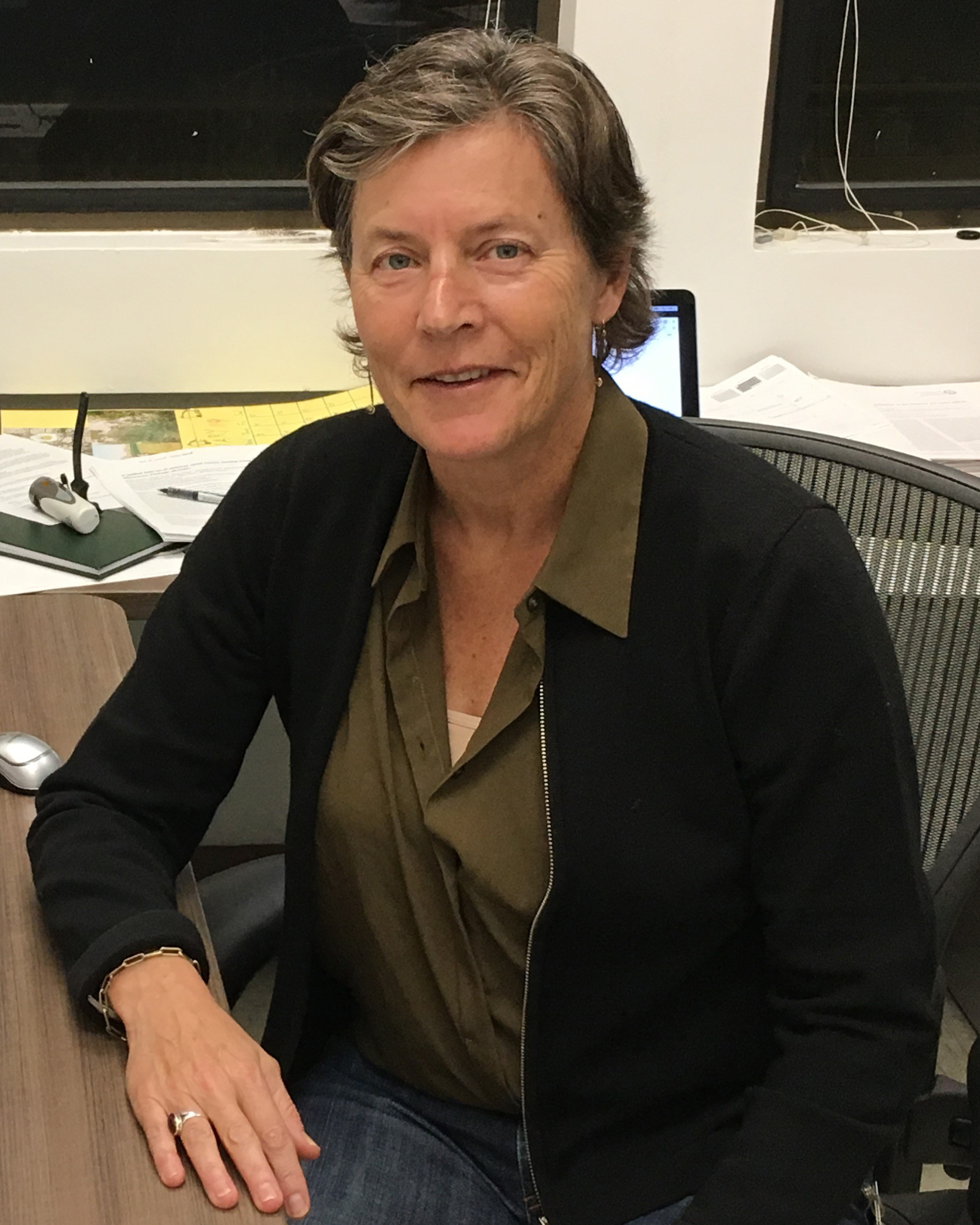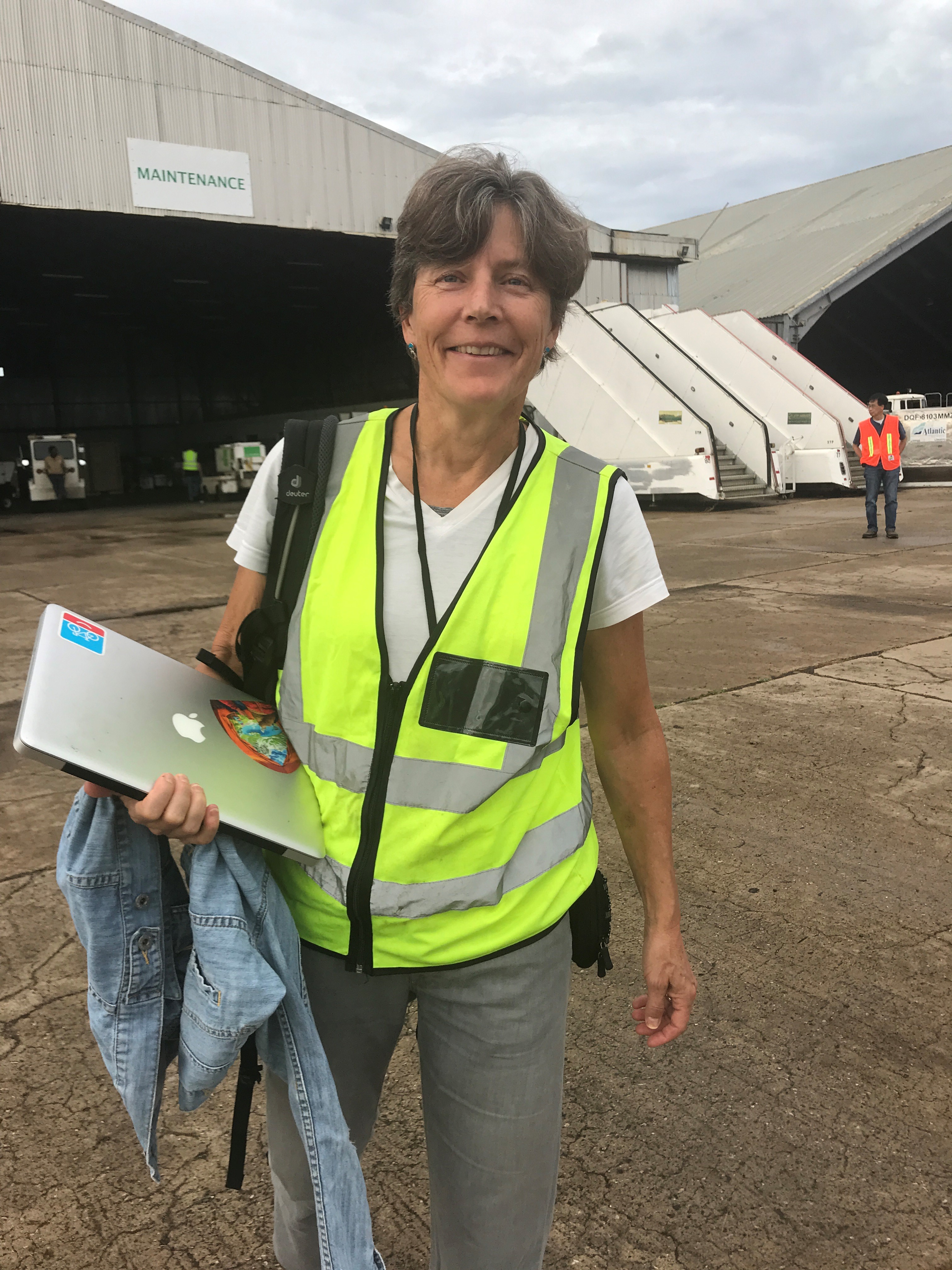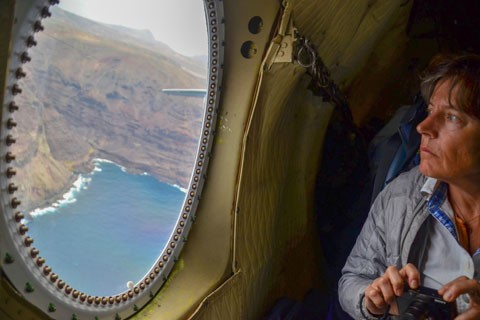UEC Profile: Cloud Modeler and Observer
Published: 19 February 2019
Starting with physics and an urge to make a difference, a veteran atmospheric scientist turned her analyzing eye to the sky
This is the second article in a series of 2019 profiles on members of the ARM User Executive Committee (UEC).

During 25 years of work as an atmospheric scientist who specializes in clouds, Paquita Zuidema of the University of Miami has studied many things that to most of us seem exotically fascinating, including shortwave-absorbing aerosols (tiny particles in the air), shallow cumulus convection, and the evolution of marine cloud systems.
Some of that research was sponsored by the U.S. Department of Energy’s Atmospheric Radiation Measurement (ARM) user facility and Atmospheric System Research (ASR) program. Other support for Zuidema’s work over the years has come from NASA, the National Oceanic and Atmospheric Administration, and the National Science Foundation.
Among her 65 peer-reviewed publications is a 2018 study Zuidema led in Geophysical Research Letters on why and when the boundary layer of the remote southeast Atlantic Ocean is smoky.
Smoke from biomass burning in Africa advects, or moves horizontally, westward over the southern Atlantic for at least one-third of every year. It contains shortwave-absorbing aerosols that can mix with a vast stratocumulus deck.
The aerosols and clouds can interact in many ways, all of which change the radiative transfer—and therefore the way the clouds influence the Earth’s heating and cooling.
“Some subtropical locations on the planet contain expansive low cloud decks,” says Zuidema, a professor in Miami’s Rosenstiel School of Marine and Atmospheric Science. They are generally proximate to deserts, span thousands of kilometers, and influence the atmosphere profoundly. One referenced in the paper adjoins the Namib Desert on the Skeleton Coast of southwestern Africa.
The paper used observational data from ARM research that Zuidema directed as lead scientist for 17 months in 2016 and 2017. The Layered Atlantic Smoke Interactions with Clouds (LASIC) field campaign set up ground instrumentation on Ascension Island in the middle of the tropical south Atlantic.
Its mission was to characterize the smoke-related aerosols and their effect on stratocumulus clouds in the marine boundary layer. Ultimately, such process-level understanding can aid earth system change predictions.
Writing the paper “was exciting,” says Zuidema. “Those were the first data from the campaign. It was good to get the LASIC view of a smoke-cloud system that up till then had primarily been characterized with satellite data.”
A New Committee Role

In 2019, Zuidema is interacting with ARM in a different way. She is one of the newest members of its User Executive Committee (UEC), an advisory group that serves as the official voice of the user community in its interactions with ARM management.
“I’m curious about their conversations,” she says of the committee, “and about how ARM is approaching this relationship. It is very relevant for the larger community.”
Zuidema sees the UEC as a way of reaching out to a broad community of scientists. “I am definitely interested in ways to make that work well,” she says.
That includes outreach to university students of atmospheric science, whose academic programs are not set up to expose them to working with field instruments.
Zuidema, an observationalist, is a particular fan of the summer classes in radar and other matters at ARM’s Southern Great Plains atmospheric observatory in Oklahoma, though she is not one of the instructors. The classes “already play a valuable role” in awakening students to instrumentation, she says.
Zuidema joined the UEC in part because she has always enjoyed mentoring younger students and practitioners.
“Maybe it’s because I don’t have kids,” she says with a laugh. “But I’m also very committed to the idea that atmospheric science will benefit from the involvement of people coming from a wide range of backgrounds and places in the world.”
The kind of science she practices is “a global enterprise” that is advanced by people with a variety of skills and inclinations, says Zuidema. “Being good at math helps, but so does having good social skills and good organizational skills.”
Growing Up and Outward

Informing all of these inclinations is Zuidema’s own background.
Born in Holland, she grew up speaking Dutch. Her father, a native of the Netherlands, influenced her with his own professional inclination toward knowing a lot about the wider world.
R. Tom Zuidema, who died in 2016, was a cultural anthropologist who specialized in South America and was an expert in the social and political organization of Andean civilization, especially the Incas.
Zuidema was only 4 when her father moved the family to Peru for a university teaching post, and just 7 when another teaching job brought the family to the University of Illinois at Urbana-Champaign.
Starting as a girl in Peru, “I got used to the idea of adapting to different cultures and environments,” says Zuidema of her international childhood. “That’s been pretty helpful.”
The family occasionally summered in Holland, and she attended eighth grade there.
From early on, Zuidema was very interested in science. “That was the one thing that didn’t change,” she says of her eclectic upbringing.
She earned a bachelor’s degree in physics (University of Illinois at Urbana-Champaign, 1983), but Zuidema was in her late 20s before atmospheric sciences took hold of her.
“I just didn’t think of it as an undergraduate,” she says. It was a time when she began trying to marry her interest in science with a passion for social causes.
Finding Clouds

Zuidema’s path to atmospheric science was circuitous, she admits. “I didn’t see a place where I really fit in very well.”
Still searching, Zuidema studied in a technology and public policy program—“optimized for technological issues,” she says—at the Massachusetts Institute of Technology (M.S., civil engineering, 1987). Then at the University of Washington, she earned two master’s degrees: in physics (1989) and atmospheric sciences (1993).
“The physics department was almost next door to the atmospheric sciences department,” says Zuidema. “I thought, ‘Maybe that’s the place I can combine my interests in science and social issues in a way that works with my more introverted, analytical personality.’ ”
She studied with Dennis Hartmann, an expert in Earth’s energy budget and climate dynamics. Right away, remembers Zuidema, “I realized it would be a good fit for me.”
From there, she entered a doctoral program at the University of Colorado, Boulder. Her husband, atmospheric scientist Brian Mapes, now a specialist in tropical convection at the University of Miami, had just finished his PhD at Washington, “and it was a place we could both go,” says Zuidema.
Earlier, during her master’s studies in atmospheric sciences, she wrote a thesis on a satellite characterization project that involved low shallow clouds—an interest in cloud type that later underpinned her PhD dissertation on three-dimensional radiative transfer with advisor Frank Evans.
Such clouds remain the biggest source of uncertainty in projections of climate change, says Zuidema, and their processes are intriguingly complex.
In 2004, ready to dig into that complexity anew and take on new challenges, she moved on to a faculty position at the University of Miami.

‘I Feel Really Lucky’
“What we know now has evolved” dramatically, says Zuidema of the state of atmospheric science. “That’s been such fun to see throughout my career.”
As a master’s student in the early 1990s, she saw little in situ data on shallow clouds and other phenomena. “But before long there was all this ARM data from so many places,” says Zuidema. “It has been a data revolution. We have so much more at our fingertips now to understand these clouds. I feel really lucky.”
Since starting out, she adds, “modeling capabilities have increased multitudes,” and instruments have become more plentiful and less expensive because of advances in small-scale electronics.
In pursuit of her corner of cloud science, Zuidema uses all this to her advantage as a practitioner of data integration—the art of combining datastreams from satellites, aircraft, ground instruments, and models to answer science questions.
“They all give you different views,” she says of the data sources.
In simplified terms, satellites provide large-scale context, but not views of small-scale processes, as ground instruments do—or vertical structure, as aircraft do.
All these views are available within ARM data, with particular strengths being the resolution of the diurnal and seasonal cycles, says Zuidema. “All that reach, 24/7, for 365 days a year.”
She may feel lucky for other reasons: loving nature, trail running, outdoor photography, hiking—and just looking up.
“I love looking at clouds,” says Zuidema, a scientist with an eye for art. “I do like thinking about why they are there. But I also think they are beautiful.”
Keep up with the Atmospheric Observer
Updates on ARM news, events, and opportunities delivered to your inbox
ARM User Profile
ARM welcomes users from all institutions and nations. A free ARM user account is needed to access ARM data.


















